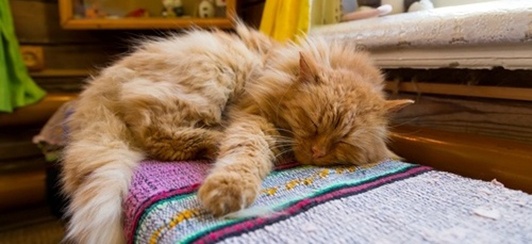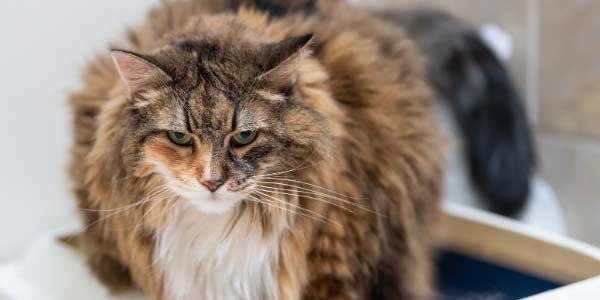- en
Pet InfoRx®
Cat Arthritis
You may be wondering if you can make a difference in your cat’s life if they have arthritis. The simple answer is – YES!
The information below will help you know what to do and how to help your kitty feel more comfortable.
Quick Links
Cats Often Suffer in Silence

Cats are masters at disguising pain. It's a survival instinct.
Important note: When touching your cat to see if they're potentially in pain, there is a chance that you or someone helping could get bitten or scratched. Even if your cat would never normally bite or scratch, the mere fact that you're checking them for pain gives them the idea that something's up!
Our mission is to help save dogs' and cats’ lives through our educational content. To support our efforts, this page may contain affiliate links. We earn a commission for qualifying purchases – at no cost to you.
What Is Arthritis?
Arthritis, sometimes called osteoarthritis (OA) or degenerative joint disease (DJD), is a degenerative, progressive, and irreversible worsening of inflammation of the joint that causes damage to the surrounding cartilage and bone. In a healthy feline joint, the cartilage acts as a cushion to allow a joint to move smoothly in a full range of motion. In an arthritic joint, that cushion is worn down, resulting in pain, inflammation, and decreased mobility. Arthritis in cats is very common, with it being the worst among older or senior cats. Cats develop arthritis most frequently in the elbows and hips, but it has also been reported in their shoulders, knees, wrists/ankles, and spine. Very typically, joints are affected bilaterally (this means that the same joint on the opposite side will have arthritis). Besides, feline obesity playing a role in developing arthritis, dislocation, trauma, or infection of the joint can lead to arthritis at any age.
Unlike dogs, cats can often tolerate or hide severe arthritis due to their small size and natural agility. In addition to this, cats resist physical manipulation and handling during examination by a veterinarian. Their general behavior during an exam makes it hard to determine if they are showing signs of pain or just resistance. Therefore, it often goes undiagnosed.
Signs your cat may be suffering from arthritis:
- weight loss
- depression
- loss of appetite
- poor grooming habits
- general change in attitude (hiding more, vocalizing, becoming aggressive to other pets and/or humans, resisting being pet)
- reluctance to jump or run
- odd or different litter box habits
- surprisingly lameness isn’t a common sign noted by owners, but your cat may show signs of stiffness and joint swelling
What Causes Arthritis?
Arthritis tends to be a complex condition that involves both inflammation and degeneration of the joint. Unfortunately, there isn’t one single cause but rather several things that influence the development and progression of the disease. Some of those factors include body conformation (how the cat is built), obesity, abnormal joint development, orthopedic surgery, trauma or injury, and nutritional issues. About 90% of cats over the age of 10 have arthritis in at least one joint.
Certainly, obesity – due to the degree of constant, low-grade inflammation that it creates in a cat's entire body – is a significant contributing factor to the development of arthritis, as is poor nutrition.
Any repetitive activity with uneven weight loading or distribution can lead to degeneration. Cats repeatedly leap and jump on and off things – a likely reason that the elbows and hips are one of the most common locations affected. Cats are also climbers and have a tendency to extend their bodies up on cat towers or similar vertical structures. This puts a repetitive strain on their hips and spine. Constant kneading at cat posts adds to the issue of arthritis too.
Any inflammation in the body, especially chronic inflammation from immune-mediated diseases, can lead to arthritis as well.
What You Should Do If Your Cat Has Arthritis
Unfortunately, with arthritis, you aren't "treating," but more so "managing" the disease. Your veterinarian will likely recommend that your cat maintain an ideal body weight and an active lifestyle. These are the two best ways to combat and slow the progression of osteoarthritis.
There are special diets that are designed to help in the management of arthritis (Royal Canin Mobility Support and Hill's j/d). Remember to follow the guidelines your veterinarian has recommended to you regarding how much you should feed.
Your vet will also likely recommend specific supplements or herbal extracts, medications, and a tailored exercise regimen to keep your cat comfortable. You must follow these recommendations closely.
Note: As mentioned earlier, diagnosis can be difficult in a cat since they aren't always cooperative during an exam. They do not typically have the same obvious signs, such as crepitus or grinding of joints that dogs do. Therefore, your veterinarian may recommend a treatment trial to see if they respond.
In advanced cases, additional medications and therapies may be helpful, including injections into the joint or those designed to prevent cartilage breakdown, laser therapy, platelet-rich plasma, stem cell treatments, physical therapy, and acupuncture.
Keep Your Cat Comfortable
Arthritis is a painful and uncomfortable disease. If your cat is diagnosed with arthritis, keep in close contact with your veterinarian and be sure to administer medications as directed.
How you can make a home easier to navigate for cats with mobility issues:
- Lay out rugs, carpet tiles, or carper runners where your cat walks most to prevent them from slipping on hard floor or tile surfaces. If your cat has a lot of fur on the bottom of their paws, they may benefit from having a trusted groomer or your veterinarian trim the fur. Extra fur on the paws can cause them to slip on hard surfaces. Also, the cat litter may stick to it, and your cat may slip trying to shake it off their paw.
- If your cat is allowed on the furniture, you may want to provide a ramp or pet stairs.
- Do your best to find ways to help your cat still enjoy things like looking out the window. Some options are ramps and stairs or move furniture so that the jumps and leaps are not as high or far.
- If your cat has to use stairs to go in and out to your yard, build a ramp so they don't have to use the stairs or leap off them.
- Add additional litter boxes to your home. If you have a two-story home, have a few litter boxes upstairs and downstairs. Be sure to also place a litter box in the room your cat stays in the most.
- Create a litter box that helps make using the potty easier. It is recommended to use a large high-sided storage container. This allows a lot of privacy (you can use the lid on top if your cat likes it), which some cats prefer, and the high sides help keep litter in the box. Cut an opening wide enough and low enough on one side so that your cat can get into and out of the box easily. Also, be sure to add plenty of litter. In addition to this type of box, underbed storage boxes work as well. Even a jelly roll pan can be used as a litter box.
- Place a non-slip mat under your cat’s litter box. This will not only help stabilize them getting out of the box but also help clean any litter from their paws — nothing worse than shaking painful joints to clean yourself.
- Be sure to move their water and food bowl to the area that your cat frequents the most. It may be necessary to have a set upstairs and downstairs – but be sure not to be feeding extra food in this instance. You may or may not need to elevate the bowls to make it easier for your cat to eat. It depends on if they eat standing or laying down.
- Get a pet bed that is easy for them to get on and off of, but also well padded. There are several comfortable orthopedic pet beds on the market.
- A warming bed designed for animals may also provide some comfort for your cat (do not use a human heating pad because they can get too hot and cause burns to your cat’s skin).
- Being painful can be distressful for some cats. Using calming products such as Feliway or VetriScience Composure treats may help soothe them.
Read more tips, details about the products mentioned above, and supplement suggestions.

How Do You Know Things Are Improving?
After your cat has been diagnosed with arthritis and has been started on medications, you should notice that your feline companion is moving better and is less painful. You will also notice your cat's mood improve!
Medications should reduce inflammation and pain and improve your cat's range of motion in the affected joints. Your kitty should be able to move and play with ease and seem more active overall.
How Do You Know When Things Are Not Improving? What You Should Do.
If your cat has not made any improvements during the first two to three weeks of medications, it is time to talk to your veterinarian. Your veterinarian may require additional testing or perhaps prescribe additional pain meds to keep your cat as comfortable as possible. During this period of time, monitor your cat closely. Their behavior and habits at home are very different than they are at the vet’s office. It is recommended to video your cat walking or moving or doing anything that seems abnormal to you. This can help your veterinarian diagnose your cat better.
The Pet InfoRx® is made possible, in part, through our partnership with AlignCare®.


© Preventive Vet. All rights reserved. PreventiveVet.com

